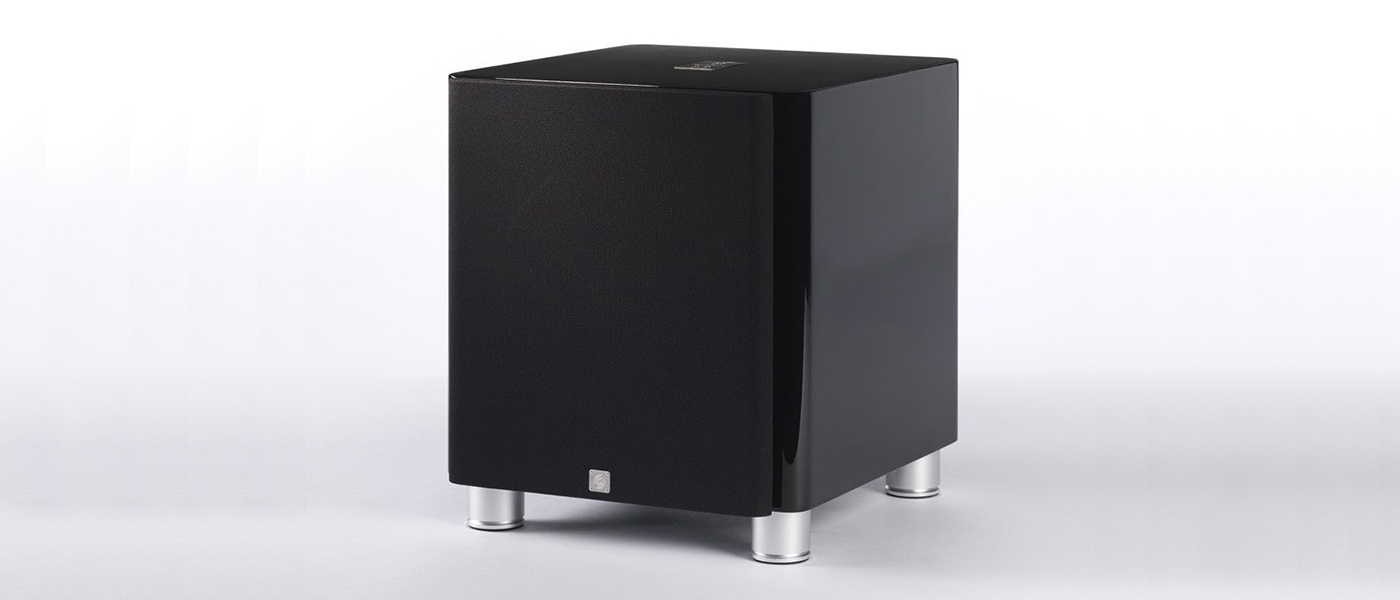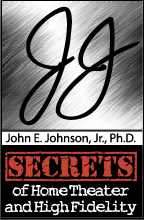What they do have is great sound – punchy and deep – with the capability of having a 6,000 watt Class D amplifier driving the main enclosure and an additional passive enclosure. You can imagine the results.
The HPi+ runs on 240 volts. I requested this because I wanted to know what the subwoofer can do when it has maximum wall voltage supply. It made a huge difference when I reviewed the Paradigm SUB 2 in November, 2010. The 240 volt Seaton version comes in at $2,995 (120 volt version is $2,695).
The Seaton has two 15″ Eminence drivers, mounted on opposite sides, to eliminate mechanical transfer of woofer movement to the enclosure. The amplifier is mounted on one of the other two sides.
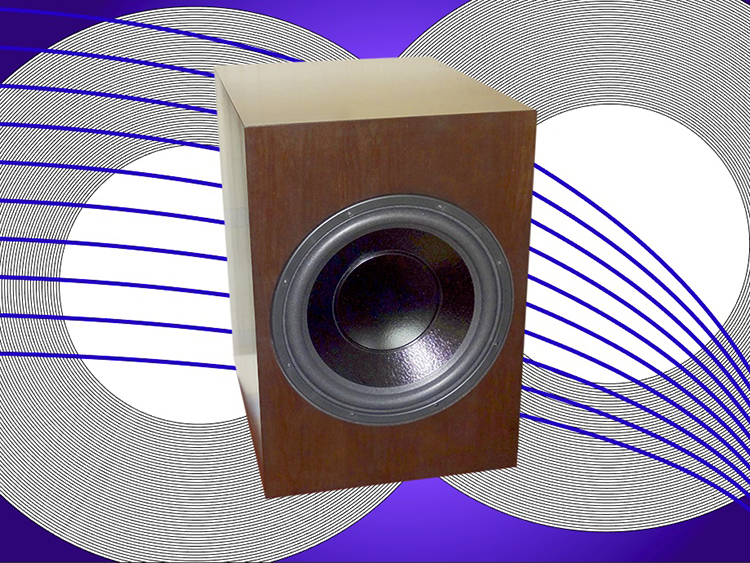
SEATON SOUND SUBMERSIVE HPI+ SUBWOOFER
- Two 15″ Drivers which move a lot of air
- Usable response down to 10 Hz
- Minimum number of knobs and switches to deal with
- Available in 240 volt version that produces more power
- Great price for so much performance
- Can also power passive slave sub which is less than half the price of the active sub
Although Seaton Sound has been around a while, you may not have run across them before. That’s because they are primarily a custom installed product. Photos of Mark Seaton on the Internet tend to be him, standing beside a column of his subs that have been installed in a customer’s home.
Design:
Two-driver, Sealed Enclosure Subwoofer
Drivers:
Two 15″; 3″ Voice Coils
Power:
2,400 watts/One Sub – 4,000 watts/One Active Sub and One Passive Sub (120 Volts AC); 6,000 watts/One Active Sub and One Passive Sub (240 Volts AC)
Program 1:
19 Hz – 200 Hz, ± 3 dB
Program 2:
15 Hz – 200 Hz ± 3 dB
Made in
USA
Dimensions:
25.5″ H x 24.25″ W x 17.5″ D
Weight:
124 Pounds
MSRP:
$2,695 USD Active Sub; $1,195 Passive Slave Sub USD
Company:
SECRETS Tags:
Seaton Sound, Subwoofers, Active, Slave Subwoofers
Nevertheless, the product is available to anyone who wants to buy one (or several) and install it (them) on their own, just as would be done with a conventional subwoofer company. They come in just a few sizes, all of them big. Usually, you would buy one subwoofer that has drivers and an amplifier, and if you wanted additional subs, you would get the passive slave version, and connect it to the power amplifier in the first sub.
This means that the amplifiers in the Seatons are very powerful, starting with a 2,400 watt Class D amplifier in the basic version, and moving all the way up to $6,000 watts in the version that I got for review, which is powered from the wall at 240 volts. The 120 volt version of this sub has 2,400 watts, and if you connect a second passive slave sub to it, the power goes to $4,000 watts.
The Seaton SubMersive subs are big, and they are powerful. They came about as a result of discussions on the AVS Forum, and the discussions of the Seaton design are non-stop.
Apparently, consumers wanted a subwoofer that they could stack in their home theaters to produce massive amounts of bass, but didn’t want to stack conventional subs with their beveled edges and numerous features that had to be set individually.
Secrets Sponsor
So, the plain Jane Seaton SubMersive came to be.
It uses custom Eminence 15″ drivers with 3″ voice coils, with the drivers mounted at opposite ends of the enclosure. The enclosures are boxes with no slope or curved surfaces, ideal for stacking.
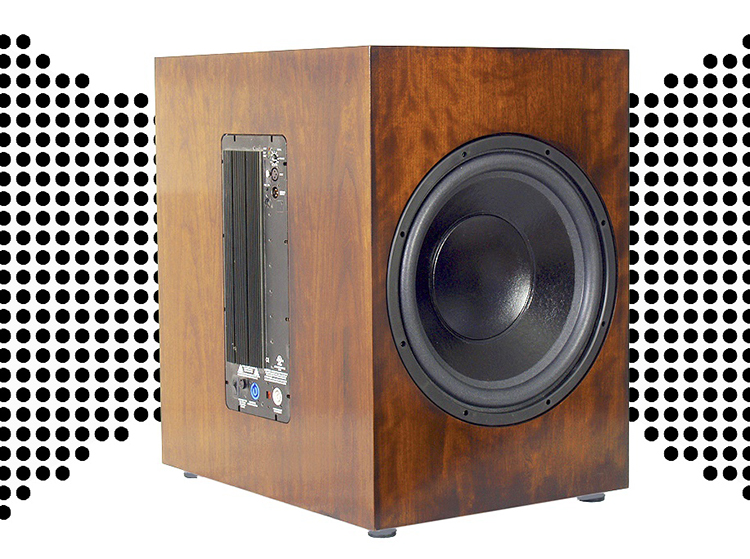
The amplifier is in one enclosure and is capable of driving several passive slaves, to the point that the impedance the active sub sees is 2 ohms. Obviously, this is a job for heavy duty Class D amplifiers, and that is what powers the Seatons.

I obtained two 240 volt versions that are meant for the European market. They will perform fine at 120 volts, but I wanted to see what the 240 volt version would do. This version makes full use of the 240 volt two-phase supply that is available in the USA. The 120 volt version uses just one of the phases.
I placed the two SubMersives next to my reference Velodyne DD-18+ subs in my home theater. All subs were in the front of the room, in the same plane as the projection screen.
Secrets Sponsor
There are two programs that can be set. Program 1 delivers 19 Hz – 200 Hz, ± 3 dB, and Program 2 gives 15 Hz – 200 Hz ± 3 dB. I went with the default factory setting, which was Program 1. There are also three LED’s that let you know when you are clipping the signal, and when the amplifier protects (limits) further increases in amplifier power.
I tested the Seatons with an OPPO BDP-105 universal Blu-ray player, Classé SSP-800 processor, Classé CA-M600 monoblock power amplifiers, and Classé CA-5200 multi-channel power amplifier. Speakers were MartinLogan CLX’s in the front, MartinLogan Summit-X’s in the rear, and MartinLogan Stage X’s for the center, and left and right side channels. Cables were Wireworld and Mogami.
The two Seatons were about six feet apart, under the projection screen, with the drivers facing front and back. The amplifier panel was on the right side.
The sound of the Seatons, in a word, was amazing. The combination of 240 volt wall supply, and having dual subs, made my hardwood floor shake, even though the floor is sitting on a concrete slab. The Seaton enclosures did not vibrate very much, which is due to the drivers being mounted at opposite ends.

My current favorite test in the movie realm is Prometheus, Chapter 32. This is where the earth ship is trying to prevent the Alien mothership from taking off on a voyage to destroy earth. Well the earth moved with the Seatons handling the obviously very low frequency engine sounds as well as the sound of the mothership crashing to the ground when the earth ship plows directly into it during its emergence from an underground cave. Friends that I demonstrated this to said they had never heard anything like it before, and were now going to consider investing in high end home theater equipment because the sensory experience was as exciting as the movie itself. (The 7.1 sound track of this movie didn’t hurt the demonstration.)
With music that has low frequency instruments (i.e., bass drum and pipe organ), the Seatons were equally at home.
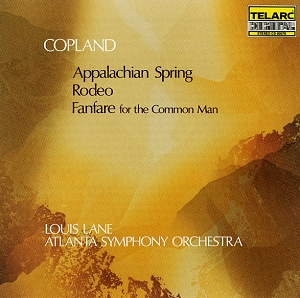
My standard for this is Copland’s Fanfare for the Common Man. If an amplifier doesn’t have a beefy power supply, or a subwoofer doesn’t have the mustard, it will show up in this musical masterpiece. Interestingly, it is an early Telarc CD, and the beginning of their reputation for putting out CDs with uncompressed sound. The intro bass drum thud is the test. Telarc re-released the disc in SACD using the original 50 kHz sampling rate of the master recording.
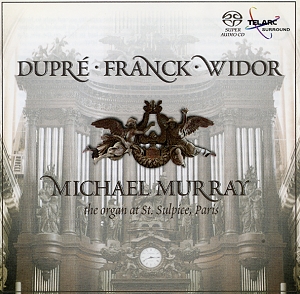
For organ music, I used Michael Murray’s Telarc SACD recording of the music of Dupré, Frank, and Widor.
To say the least, the low pedal tones thundered not only in my ears, but my chest as well.
Compared to my Velodyne reference subs, the Seatons had a little more punch, while the Velodynes had more of a deep rumble. This is due likely to the slightly smaller diameter of the Seaton subs, which give the amplifier more control over their lower mass.
All distortion measurements were made within an 80 kHz bandwidth and with the microphone 2 meters from one subwoofer (I used only one sub for the measurements). For the frequency response, I placed the microphone 18″ from the center of one of the drivers.
At 10 Hz, I was able to get 90 dB max, due to the limiter, and using Program 1. I didn’t tempt fate by raising the default setting, or changing to Program 2, as I have blown up subwoofers using such low sine wave frequencies when there was no limiter. So, although it was limited, the sub does put out usable (although highly distorted) sound at 10 Hz. With Program 2, you can expect a bit more output at 10 Hz, although the only recording I can think of that has sound in this range is Jurassic Park.
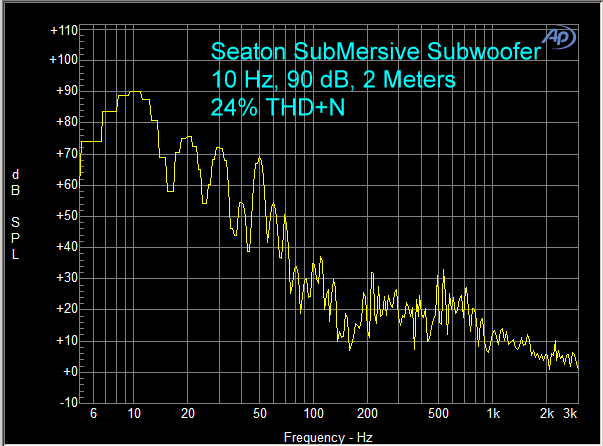
At 15 Hz, THD+N was less than 2% at 100 dB output, which is very good. So, let’s just say that the sub is great down to 15 Hz, and lower than that, it will deliver the sound, but at high distortion.
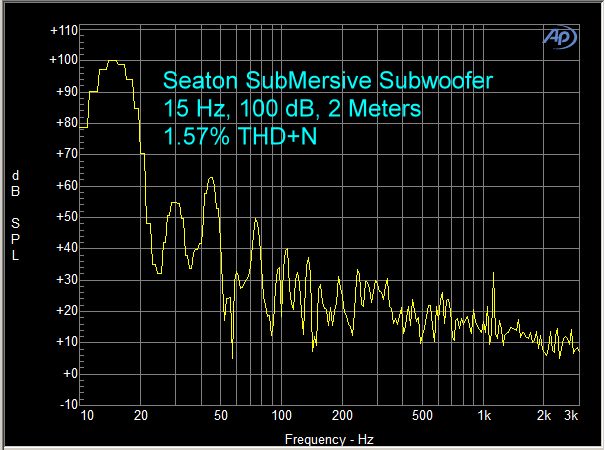
Raising the output to 110 dB and 15 Hz, distortion was less than 5%. Extraordinary.
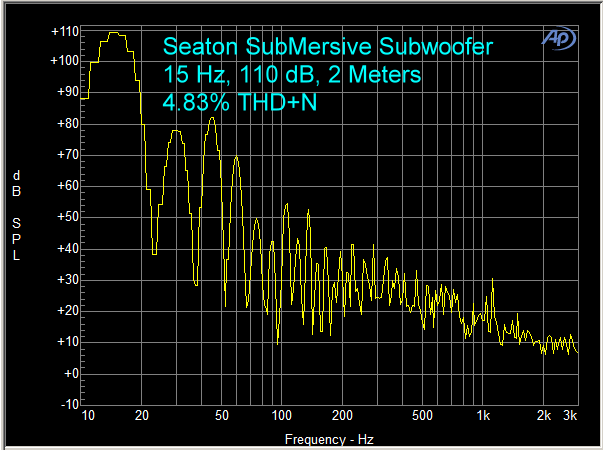
At 20 Hz, distortion was a bit lower than at 15 Hz. Less than 1.5%.
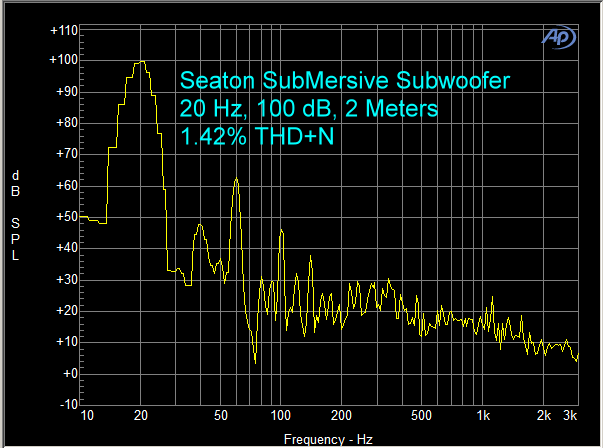
Distortion continued to be lower, as I raised the test frequency, such as here at 25 Hz.
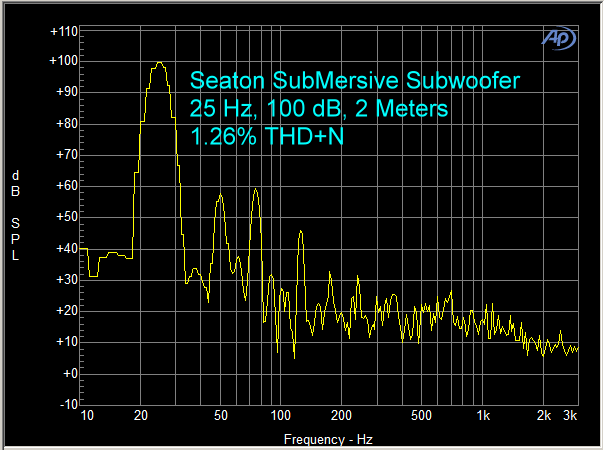
At 30 Hz, distortion actually went below 1%. If you haven’t noticed yet, the bench tests were turning out to be really superb.
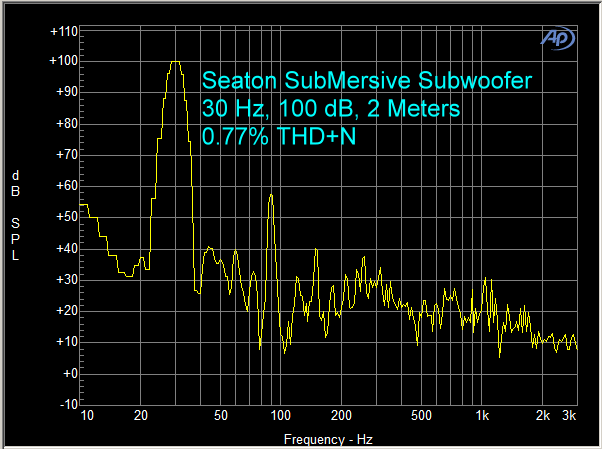
At 40 Hz, it is no surprise that the distortion was even lower.
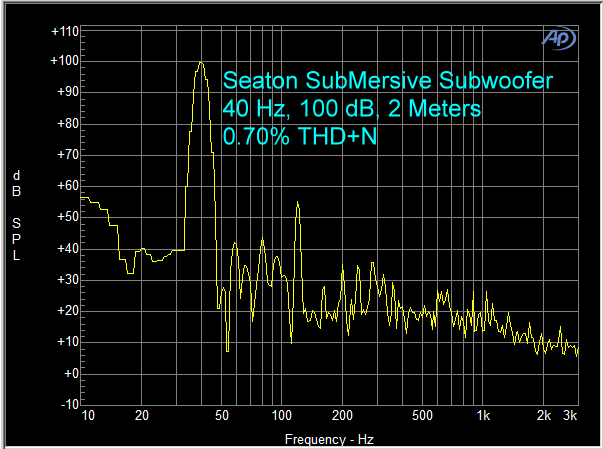
At 50 Hz, distortion was less than 0.5% THD+N. Popcorn anyone?
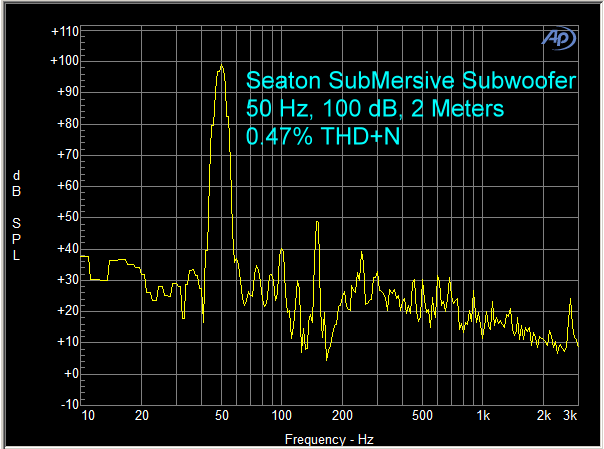
The frequency response was measured at 18″ because there are two drivers on the sub, one at each end. Placing the microphone farther away would produce spurious results.
The response appeared to be rather flat if you take out the room nodes that were still present even at 18″. Notice that it went down to 10 Hz. I would estimate a roll-off at about 15 Hz.
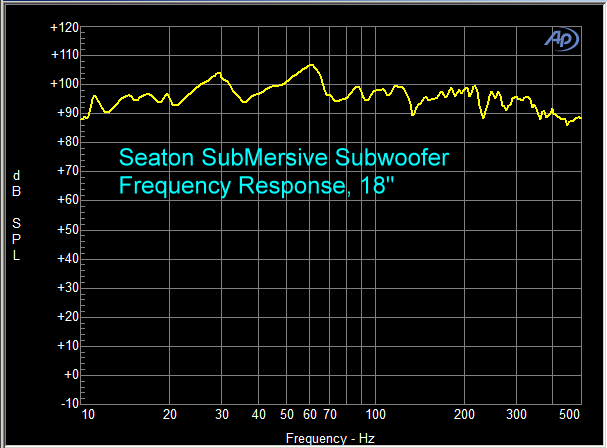
THE SEATON SOUND SUBWOOFERS ARE HIGH-PERFORMANCE.
- Very powerful amplifier which delivers high output SPL
- Simple user interface
- 240 volt option for extra output
- Force cancelling arrangment of the two drivers on opposite sides of the enclosure
- Usable output down to 10 Hz
- A larger volume control dial
- A selection of wood veneers
- An RCA input (it only has an XLR input)
Seaton is definitely a contender in the subwoofer market. Although intended primarily for custom install, there is no reason not to just purchase them for your own home theater and put one or more in yourself. They come in several colors, including the Espresso Cherry stain that mine came in. Highly recommended!
Mark Seaton responds to the review with a bit of the nine year history of Seaton Sound:
“There have been 2 major amplifier upgrades from an original 1000W ICEpower based amplifier to the 2,400W amplifier (no longer offered as new), the F2 version and then 2 years ago when we introduced the + models which indicate the ability to drive 2 cabinets to the same level as one (double the current capability for 2 Ohm loading). While we have stacked a few in larger rooms and at trade shows, we can easily run 35-50′ of the 4 conductor #11 wire with no significant loss powering the slave unit. The twist-locking, 4 pin SpeakON connector insures the customers can’t mis-wire the slave unit if the cable is made properly.
For enclosed home theater spaces we repeatedly found customers would get the best results with a front and rear grouping of subwoofers, typically with a delay on the rear subwoofers. Both modeling and real world testing confirmed most room correction systems would give worse results when they try to separately calibrate 2 subwoofers placed along the front wall, or otherwise the same front to back distance (ie middle of each side wall or both at rear). The HP+ & HP-Slave (or front firing F2 version) work as a great way for customers to assemble/upgrade their system in pieces with many having the end goal of an + & slave unit at the front wall with another + & slave unit at the rear wall for a total of 4 dual 15″ subwoofers in the room. In any enclosed space extension is typically in the 8-14Hz range as I designed the roll-off shape to provide a best fit to measured room gain profiles. With the introduction of the 2400W SubMersive HP I added a 2nd response curve in the “program 2” DSP setting when the new amplifier allowed for more bullet-proof and benign over-excursion limiting. The “15Hz” response is an carefully shaped, +3.5dB low shelf to the standard response curve that transitions just below 20Hz to just above 50Hz.
This offered 2 very useful benefits. For larger spaces with less room gain the curve was a better starting point and fit, and the +3.5dB shelf was subtle and smooth, but audible enough to be very useful with room correction systems like Audyssey & ARC. Customers can run correction which bulldozes the response flat with the subwoofer set to the 19Hz mode, and then after experiment in switching to the 15Hz mode which gives an often welcome, but mild tilt to the bottom end (+3.5dB shelf to the corrected response). I describe the subjective difference as being more “whallop and weight” vs. more “intensity and impact” when left in the 19Hz mode. Note the only change is to the response curve. Distortion and maximum output at any frequency does not change.
I mistakenly thought Kelly forwarded the link to the page here on our forum where I have a connection and setup guide for the SubMersive. Normally this is linked when we send the final invoice. If you do any experimenting with the PGM SEL button in the 19Hz (IN) and 15Hz (OUT) modes, please note the main power switch must be cycled to load the DSP program as it only looks at the position of the switch at power up. Pressing the PGM SEL button while playing will have no effect.
Thank you for putting so much time and effort into the review. It is appreciated.”
Mark Seaton


